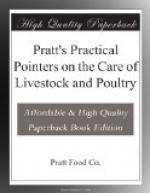At no time in the life of a dairy cow should she be allowed to suckle her calf longer than the third day of its existence.
In certain parts of the country, especially where whole milk is sold for consumption in the cities, dairy-men frequently kill calves at birth because of lack of milk for feeding them. This practice is wrong and unnecessary. All strong calves should be grown, either for milking animals or veal. And this can now be done, easily and cheaply, by feeding Pratts Calf Meal, the perfect milk substitute, the guaranteed “baby food for baby calves.” When this scientific food is used, calves of really superior quality, big, sturdy, vigorous, are grown practically without milk.
Pratts Calf Meal must not be confused with coarse mixtures of mill by-products sometimes sold as “calf meal” or “calf food.” Pratts is as carefully made as the baby foods which are so widely used for children. It appeals to the calf’s appetite, is easily and quickly digested, produces rapid growth and even development. It does not cause scours and other digestive troubles. And it is easy to prepare and feed.
[Illustration: SHORT HORN COW]
In chemical composition, Pratts Calf Meal is practically identical with the solids of whole milk. It is made exclusively of materials especially suited to calf feeding and these are always of the highest quality obtainable. This is one secret of the great success of this truly remarkable feed.
The various materials are ground very fine, milled separately, and are then bolted to remove any coarse particles. They are then combined in exact proportions and thoroughly mixed.
Finally, the mixture is steam-cooked, which makes the feed easy to digest and assimilate. This expensive, but most necessary process, prevents indigestion and bowel troubles which accompany the use of unbolted, uncooked meals.
Where milk is available for calf feeding the following plan may be used:
The young calf should take milk from its dam for, say, three days. During that period the milk is only fit for feeding purposes. It is very important that the calf shall be started right, and in no way can this be done so well as by Nature’s method, that is, by allowing it to take milk from the dam at will. At the end of that time it should be taught to drink. This can usually be accomplished without difficulty by allowing the calf to become hungry before its first lesson in drinking. It should be given all whole milk, for say, two weeks. This given in three feeds per day, and not more in quantity, as a rule, than two quarts at a feed.
The change from whole to skim-milk should be made gradually. A small amount of skim-milk should be added to the whole milk the first day, and a corresponding amount of whole milk withheld. The amount of skim-milk increased from day to day, and the whole milk fed decreased correspondingly. The time covered in making the change from all whole to all skim-milk should be from one to two weeks. Any skim-milk that is sweet will answer, but it should not be fed to young calves at a lower temperature than about 98 degrees in winter. Milk obtained by cream separators, soon after drawn from the cow, is particularly suitable.




